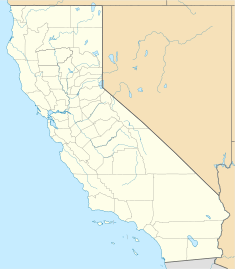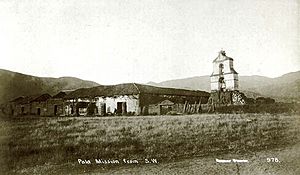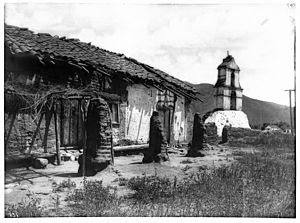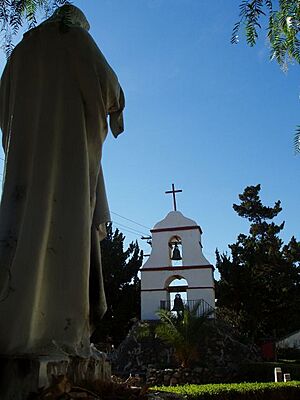San Antonio de Pala Asistencia facts for kids
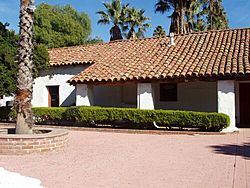
The modern capilla (chapel) at "Pala Mission."
|
|
| Location | San Diego County |
|---|---|
| Coordinates | 33°21′40″N 117°4′45″W / 33.36111°N 117.07917°W |
| Name as founded | Asistencia de la Misión San Luis, Rey de Francia |
| English translation | Sub-Mission to the Mission San Luis Rey de Francia |
| Patron | Saint Anthony of Lisbon, Portugal and Padova, Italy |
| Founding date | June 13, 1816 |
| Founding priest(s) | Father Antonio Peyrí& |
| Military district | First |
| Native tribe(s) Spanish name(s) |
Payomkowishum Luiseño |
| Native place name(s) | Pale |
| Governing body | Roman Catholic Diocese of San Diego |
| Current use | Parish Church / Museum |
| Reference no. | #243 |
| Website | |
| https://missionsanantoniodepala.org/ | |
The San Antonio de Pala Asistencia, often called the "Pala Mission", was started on June 13, 1816. It was an asistencia, which means a "sub-mission." It helped the main Mission San Luis Rey de Francia, located about twenty miles away. Pala Mission was part of a larger system of Spanish missions and outposts in Alta California.
Today, Pala Mission is found on the Pala Indian Reservation in northern San Diego County. Its official name is Mission San Antonio de Pala. It is special because it's the only historic mission that still serves a Mission Indian tribe. The name "Pala" comes from the native word Pale, which means "water."
The site was first explored in 1795 by Father Juan Mariner and Captain Juan Pablo Grijalva. They found the area to be a good spot for a mission. When Mission San Luis Rey became successful, many mountain Native Americans became interested. The Spanish called these people the Luiseño.
Contents
Spanish Era: Building the Mission
The Franciscan fathers chose this spot for Pala Mission because it was a traditional meeting place for Native Americans. Father Peyrí oversaw the building of a chapel and housing. These were added to a granary (a place to store grain) that was built in 1810.
Native artists painted the inside walls of the chapel. Workers went into the Palomar Mountains to cut down cedar trees. These trees were used to make the roof beams for the buildings.
Pala Mission is unique among all Franciscan missions. It has the only completely freestanding campanile, or "bell tower," in all of Alta California. By 1820, about 1,300 baptisms had taken place at this outpost. There's a folk tale about a prickly pear cactus that grew at the foot of the cross. It became a local symbol of Christian victory.
Mexican Era: Changes and Challenges
After Mexico became independent from Spain, the Mexican Congress passed a law in 1833. This law was called the Act for the Secularization of the Missions of California. It meant that the missions would no longer be controlled by the church.
In 1835, Father Buenaventura Fortuna gave up Mission San Luis Rey and all its lands. This included Pala Asistencia. The Mexican government took control of these properties. Later, in 1846, fearing that the United States would take over California, the land was sold. However, the U.S. Government later said this sale was not valid.
Even with these changes, priests from San Luis Rey continued to visit Pala. They performed baptisms, marriages, and held worship services for the people there.
Modern Era: Restoration and Community
On Christmas Day in 1899, a large earthquake hit the Pala Valley. The earthquake caused the roof over the church sanctuary to fall down. In 1902, a group called the "Landmarks Club of Southern California" bought Pala Mission.
The next year, the Club gave ownership back to the Catholic Church. They also helped save the chapel and some rooms from complete ruin. They did some important restoration work.
Pala is the only California mission that has continuously served the Mission Indians. It was originally built for them. It is also the only sub-mission (Asistencia) that is still standing today. The traditional Corpus Christi Fiesta has been celebrated there every year since it was founded.
Even without a full-time priest, Pala served as a "mother" mission. It supported chapels in nearby communities like Cahuilla and Temecula. In 1948, the Verona Fathers took over care of the Mission from the Franciscans. They completed a full restoration of the Mission in 1954. Since 1996, the Barnabite Fathers have been in charge of the Mission.
Since 1996, Pala has also been home to the Vivian Banks charter school. This school serves children from Kindergarten to 5th grade.
Mission Bells: Sounds of Daily Life
Bells were very important for daily life at any mission. They were rung for mealtimes and to call people to work. Bells also called residents to religious services, births, and funerals. They would even signal when a ship or a Spaniard was approaching.
Newcomers learned the special ways to ring the mission bells. Pala's bells are the same ones that have been used since 1916. The original bell tower was destroyed by heavy rains in 1916. A perfect copy was built right away, and it still stands today. This tower is about 35 feet tall above its base. It holds two bells, each hanging from a rawhide rope.
The larger bell is in the lower opening. It has words in Latin and Spanish that mean:
- "Jesus, Redeemer of Mankind, Holy God, Holy Mighty One, Holy Immortal One, Have Mercy on us. Year of our Lord 1816"
- "Cervantes made us."
- "In honor of Our Seraphic Father, Francis of Assisi, San Luis King, Saint Clara, Saint Eulalia, Our Light."
The smaller bell is in the upper opening. It has words in Latin that mean:
- "Jesus + Mary"
- "Holy God, Holy Mighty One, Holy Immortal One" and "Have mercy on us."
See also
- List of Spanish missions in California
- Mission San Luis Rey de Francia
- Las Flores Estancia
- Luiseño—Mission Indians
- California mission clash of cultures
- Mission De Pala – a ship built during World War II.


